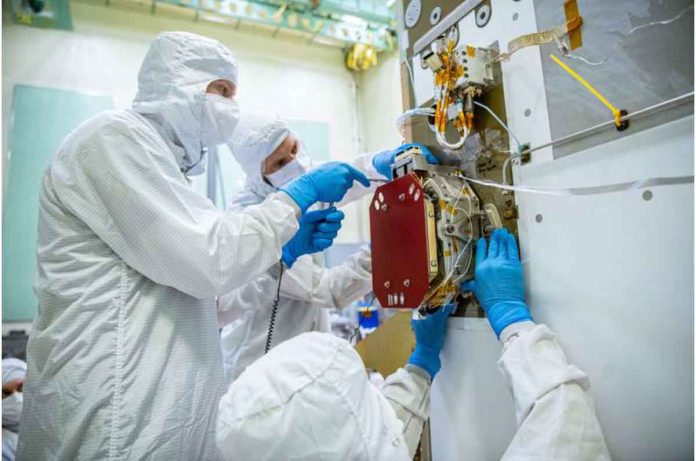A team of engineers from SRON Netherlands Institute for Space Research, Airbus Netherlands, and NASA has been working on installing the Dutch aerosol instrument SPEXone on NASA’s PACE satellite for the past few weeks. PACE will collect data on oceans and aerosols to investigate the impact of particulates on climate. It is set to go live in 2024. The final screw is tightened on June 23, officially completing the integration.
The climate satellite PACE was waiting for her first measurement instrument at NASA’s Goddard Space Flight Center in Maryland on June 8 when a group of Dutch and American engineers walked into the cleanroom. SPEXone, along with HARP2 and OCI, will provide the spacecraft with a razor-sharp view of the Earth, allowing it to measure the colour of its oceans and map the properties of aerosols. The Dutch SPEXone instrument, developed by SRON and Airbus Netherlands with support from TNO, is responsible for aerosol measurements alongside HARP2 and is now the satellite’s first instrument.
Aerosols are tiny dust particles in the air that include soot, ash, and desert dust. They have a significant impact on air pollution and climate change, but their precise role is unknown. As a result, scenarios for global warming up to the year 2100 differ by about 3 degrees Celsius. Most aerosols reflect light and thus cool the Earth, but they can also warm the Earth due to absorption. Aerosol properties such as size, shape, composition, and absorbing/reflecting power will be mapped out by SPEXone. It also assists the OCI instrument in measuring the colour of the oceans and, as a result, monitoring the amount of plankton. Because of aerosol scattering, a correction is required.

SPEXone was completed in the Netherlands in February 2021, in the presence of the Dutch science minister, and was transported to Goddard. The Dutch team has since conducted several tests to ensure that the instrument arrived in one piece and survived months of storage. “But this is the most exciting moment,” says SRON engineer Alexander Eigenraam as he prepares to travel to the United States.
“The alignment must be precise. We must especially ensure that it is not slightly twisted. We mount SPEXone on the satellite’s vertical side, which makes it even more difficult. We also need to use NASA’s test systems and electronics.This is required because SPEXone is now linked to the satellite and no external computers are permitted to connect to it.”

The Dutch SPEXone instrument is a potential candidate for inclusion in the European CO2M satellite, which will map CO2 concentrations in the Earth’s atmosphere. Aerosols affect CO2 measurements, so corrections require an aerosol instrument.

